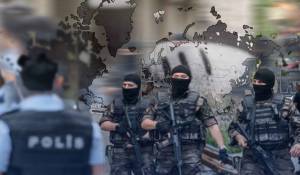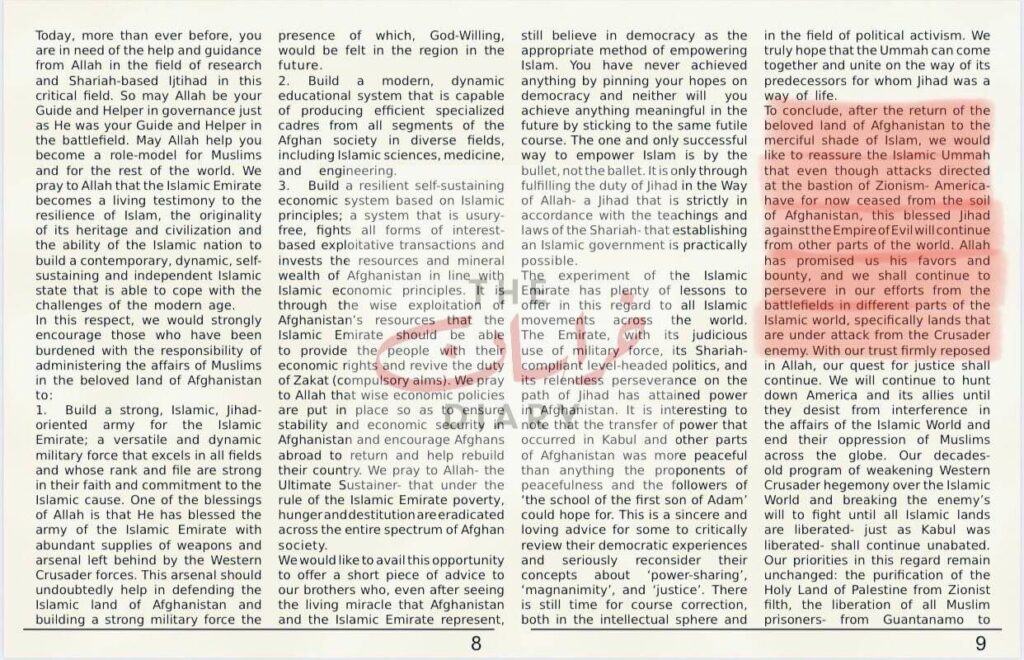
TKD Team

December 13, 2025
By | TKD Team

Picture of the video released by Islamic State Khorasan Province (ISKP) on the wake of the killing of Zawahiri, September 2022.
Al-Qaeda is passing through a difficult succession process after the killing of Ayman al-Zawahiri in a US drone strike in Kabul on July 31. The appointment of the next leader is the crucial stage as it may pave the way to create a new strategy for the organization.
One of the top contenders in the line of succession is Saif al-Adel, who is a 62-year-old Egyptian veteran and was a military strategist of the old guard. He is supposed to be currently under house arrest in Iran. Adel’s choice would bring continuity between Zawahiri and the new leadership. However, Osama bin Laden had also cast doubts on his suitability for general leadership.



Based in Afghanistan, AQIS is certainly affected by the death of Zawahiri. In an exchange letter between AQIS Emir Usama Mahmood and Tehreek-e-Taliban Pakistan (TTP) leadership in 2020, AQIS revealed its full support for the Afghan Taliban, while asking TTP to lay down their weapons against Pakistan and not to damage relations between the Afghan Taliban and the Pakistani government.
In the letter, AQIS disclosed its strategy of avoiding conflict with a Muslim government, whereas it is preferable to attack Western (and allies) targets within Muslim countries such as Yemen and Mali; for this, AQIS suggested using Afghanistan as a platform for attacking the states such as Kashmir, India, and Bangladesh. On the other hand, TTP offered AQIS a merger to avoid its disintegration, as TTP claimed that AQIS was being perceived as weak.
It should be noted that no al-Qaeda franchise has yet commented on the strike on Zawahiri. However, on October 24, al-Qaeda’s longtime allied TTP published Issue 10 of its Urdu language magazine Mujalla Taliban, featuring an article from Maulana Saleem on page 16 that mentioned Zawahiri as having been “martyred” in Kabul by the US with the complicity of the Pakistani government. Such an independent decision by the TTP, together with Mufti Noor Wali Mehsud’s public claims that the movement does not enjoy any ties with al-Qaeda, is in contrast with AQIS’ full endorsement of support to the TTP policy vis-à-vis the peace talks with the Pakistani government, as announced in AQIS magazine Nawa-e-Ghazwa-e-Hind’s October Issue. This development sheds light on the controversial relationship between AQIS and the TTP in wake of the latest developments in the region.
The death of Zawahiri and the selection of a new leader will impact both AQC and AQIS in their freedom movement in Afghanistan and also their collaboration with the new Afghan government, as the former might hinder AQIS plans for opening a ‘jihadi’ front in Kashmir.
For AQIS, it will become increasingly difficult to operate both in Afghanistan and Pakistan, given the priorities of the current Afghan government (related to internal stability and international recognition) and the hostility of the TTP to AQIS intromission.
Although since 2020, and particularly this year, AQC and Zawahiri seemingly supported the idea of opening a ‘jihadi’ front in India, with Zawahiri frequently capitalizing on sectarian events in the Subcontinent during his videos and speeches.
As al-Qaeda head, Adel could exercise his knowledge as a military strategist to revamp al-Qaeda operations in specific areas, while maintaining his typically pragmatic approach. One of these areas could be the Syrian theatre, where al-Qaeda is extremely weak currently. During the shift of Jabhat al-Nusra from al-Qaeda to an independent entity, Adel allegedly tried to exert his influence over the ‘jihadist’ coalition to keep it tied to al-Qaeda.
Having served as a military commander and top strategist in East Africa and Somalia, the Gulf, and Afghanistan, and known for his more balanced approach, he was also close to Osama bin Laden and Zawahiri (even though with differences), potentially providing continuity with the two previous leaders.
Moreover, his potential selection to the general leadership could boost his project of injecting new life into al-Qaeda’s Syrian branch, Hurras ad-Din (HaD), by negotiating an alliance with the remaining Salafi-jihadist factions around Idlib.
Finally, his alleged good relationship with Abu Musab al-Zarqawi during his years in Afghanistan, and the fact that he never issued any statement against the Islamic State, could also provide him with the opportunity to attract the sympathy of dissatisfied IS members, provided that al-Qaeda can regain strength under his command.
Despite the alleged good relationship, the fact cannot be ignored that competition with IS will also get affected by the death of Zawahiri. The two groups are competing for supremacy, and two major battlefronts are Khorasan (Afghanistan and Pakistan) and Africa, particularly the Sahel region, Nigeria, and Somalia.
The new leader of al-Qaeda might assume a proactive posture toward IS activities in both regions, as Islamic State Khorasan Province (ISKP) challenges the major ally of al-Qaeda – the Taliban – and the Islamic State in West Africa (ISWAP) and Islamic State Sahel Province competes with Ansaru and Jamaat al-Nusrat al-Islam wal-Muslimin (JNIM).
In Afghanistan, al-Qaeda enjoys limited freedom. During the last years, AQC lost top members in Afghanistan, such as Abu Muhsin al-Masri, and previously in 2014, when IS initially spread into Khorasan, several prominent al-Qaeda figures switched sides and joined ISKP.

ISKP is now one of the most successful provinces of IS and has enacted a long-term strategy to counter the Taliban from moving from an insurgency movement to a proper government. It is most likely to prolong the conflict between the Taliban and ISKP and it will also drag al-Qaeda into the confrontation, providing the Taliban with help and potentially strengthening the alliance between the new Kabul government and al-Qaeda.
As al-Qaeda and IS battle for supremacy over the Salafi-jihadist global movement, Khorasan and Afghanistan specifically play a symbolic and strategic role, with many potential recruits for both organizations.
However, AQIS and AQC would find it difficult to openly operate from Afghanistan, hence the clash with ISKP could provide an opportunity for al-Qaeda to share a common enemy with the Taliban, who might allow more freedom to al-Qaeda in return.
Most likely, whoever might become the next al-Qaeda leader will have to find a pragmatic agreement with the Taliban leadership, enjoying a limited advisory role in exchange for protection and the possibility to consolidate the organization.
This can happen even in the case that the next al-Qaeda leader is present in Iran, as he will likely be moved from Iran to Afghanistan with the Iranian government maintaining leverage on him by keeping his family in Iran (this would be allegedly the case of Saif al-Adel).
In Nigeria, al-Qaeda is now allegedly stronger than it was before. Despite losing the connection to its only affiliate – Boko Haram – in 2014-15 in favour of ISWAP, in early 2020, the group Ansaru – an al-Qaeda affiliate in Nigeria closely linked with AQIM which went silent for years – carried out its first operation since 2013.
The group today is active both militarily and in the propaganda department, with magazines being published by al-Qaeda media channels, and it is competing with ISWAP over the predominance of Boko Haram remnants and factions in Nigeria.
As IS can still claim superiority in Nigeria, the new al-Qaeda leader might decide to devolve more resources to Ansaru. Moreover, as JNIM is expanding its areas of operations outside of Mali, a possible decision by the new leader could tighten the links between Ansaru and JNIM, particularly if the new leader stands out for its strategy skills.
This might become necessary for al-Qaeda as its strong affiliate JNIM is actively fighting the newly-born Islamic State Sahel Province in Burkina Faso and Mali, as the latter spreads its tentacle also into Niger. On July 17, the Islamic State Sahel Province claimed that 11 members of al-Qaeda (JNIM) had defected to the IS province by swearing allegiance to the new IS leader. The two groups compete also in the target selection for a public image in the region, as they both claimed attacks against Russian private contractor “Wagner” in Mali.
It is evident that the two groups are trying to counter each other in the broad region of the Sahel and Sub-Saharan and Central Africa. As al-Qaeda lost its grip in Syria as well as freedom of movement in Afghanistan, the organization might decide to allocate more resources and efforts to its African branches.
As competition between al-Qaeda and IS for supremacy over the global Salafi-jihadist movement is also conducted online, the next al-Qaeda leader in charge might decide to change the approach of the organization to the media appearance. With Zawahiri, an agreement with the Taliban limited the leadership’s online public presence – thus avoiding issues for the Taliban by concealing al-Qaeda’s presence in Afghanistan. Moreover, Zawahiri’s public appearance has featured mainly in traditional religious and rhetorical tirades, starkly contrasting with the more dynamic propaganda by IS. The new al-Qaeda leader might have to adopt a new proactive media strategy to counter IS, although he will have to face a difficult decision.
Engaging in a new media warfare with IS might boost al-Qaeda’s public appearance, appealing to new recruits and affiliates; however, it will also be extremely risky for the safety of its leaders. Moreover, an additional issue will emerge from the fact that this will go against the Taliban’s policy vis-à-vis al-Qaeda and its presence in Afghanistan, hence highlighting the differences between Taliban-Qaeda relations.
Al-Qaeda has repeatedly stated in its publications that the group does not need to carry out a similar attack to 9/11. Additionally, looking at al-Qaeda and its affiliates, the operations that are currently being carried out target the “Near Enemy”, specifically the governments of Muslim-majority countries and Western targets within those countries.
However, given the perceived weakness of al-Qaeda, the new leader might try to invest in new attacks far from its usual operational areas, internationalizing its activities with operations that might hit the West. By broadening the scope and horizon of its operations, al-Qaeda will attest to its strength across the Salafi-jihadist community, and it could be vital for the immediate post-Zawahiri death period.
Hence, al-Qaeda’s new leader might adopt – totally or in part – al-Qaeda in the Arabian Peninsula (AQAP) style of international attacks, particularly if AQAP leader Khaled Batarfi is selected as the new leader.
This latter case seems to be unlikely since Khaled Batarfi is hardly fitted for leadership and his branch is suffering from internal ruptures; however, the international pulsion that characterized AQAP in recent years might be appealing for the new al-Qaeda leader, especially if he is from the second generation of al-Qaeda leaders as Batarfi himself.
A leader from the old guard may be selected, but AQC would still have limited capabilities in its movements in Afghanistan and Pakistan as a result of the priorities of the Taliban government, namely internal stability and international recognition. The new leader would likely follow Zawahiri’s path of the silent and slow rebuilding of al-Qaeda under the shadow of the Emirate, strictly checked by the Taliban. Branches will continue to operate as before, and no attacks in the West will follow. Attacks against Western targets or allies might occur in areas where al-Qaeda branches are present.
Meanwhile, a leader with a more proactive vision can be selected, emerging might be from the second generation but not exclusively. Depending on the selected leader, the organization might decide to try to revamp its operations in new areas, either aiding the Taliban in Afghanistan against ISKP; in Africa against ISWAP and Islamic State Sahel Province; or in Syria by injecting new life into the Syrian project of HaD. Online warfare will be boosted for countering IS dominance, but relations with the Taliban might become progressively tense.
Al-Qaeda will unlikely become progressively weak, regardless of the selection of the new leader. The organization will lose control over its affiliates and branches which either become independent by settling conflicts through individual armed struggle or by negotiating a political settlement with their enemies, as AQIM once ventilated after the victory of the Taliban. Former allies of al-Qaeda might defect and join IS.